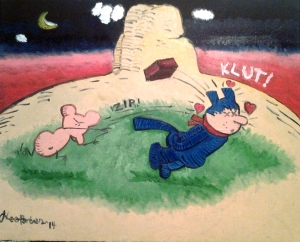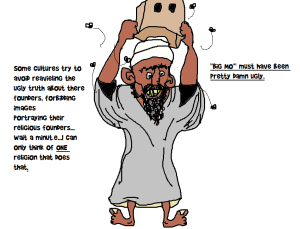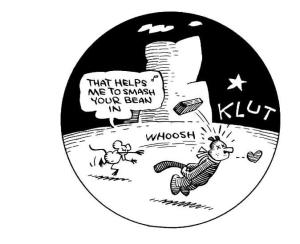Category Archives: Opinion
1/3/2015 – The “Truth” About Krazy Kat?
The “Truth” About Krazy Kat? by H. Lee Parten
January 2, 2015 at 11:26pm
“Four-Color Brick Brutality,” by Hourthirteen
I oil paint from time to time – scifi themes, classic art forgeries, land]scapes, etc. Some of these I have on my wall in my bedroom..I was in bed this morning just starering at the pictures on my walls, particularly my latest painting, Ignatz Mouse beaning Krazy Kat with a brick. And then I started looking at it metaphorically…and I realized: My God! The picture if full of sex! Look at the two pictures here, one is the original art and one is my painting. I duplicated the panel almost exactly, except I changed the sound effect of the brick hitting Krazy’s head, and slightly curved the horizon a little more than it is in the original. The colors are based on the coloring used in the Sunday comics, and the setting is a flat, dessert-like Arizona, with a few towering rocks and mesas.
So look at it…See the phallic symbol? The position of the brick? The clouds? Interesting. If you’re only familiar with the limited animation television cartoon of the early 60s, you may not know that Krazy Kat was probably comics first transgender character. That’s right, she was definitely female in the cartoon, but in the strip, Krazy’s sex was malleable – in some strips she was referred to as a “she,” but in others as a “he,” depending on the situation, or seemingly, the whim of George Herriman, the strip’s creator. Either way, Krazy’s personality was consistent; dreamy, poetic, befuddled…the epitome of a “sensitive” type who may not be sure of her/his own identity.
Now what makes it even weirder is that Ignatz is definitely male. (He is shown with a wife and a ratpack of children in several strips.) He doesn’t seem to HATE Krazy Kat, but he rejects her/his total adoration in the most violent way. This is typical behavior of someone repulsed by what they see as an unwanted and “unnatural” interest, which would certainly be applicable to a cat in love with a mouse. Ignatz is also disrespectful to the local law, represented by Offica Pup. Meanwhile, Offica Pup is also male, and he is in love with Krazy, and the strip is ostensibly about Pup’s efforts to stop Ignatz from assaulting Krazy with bricks. Krazy sees Offica Pup’s affection for her/him as simple, almost casual, acquaintance, and never seems to notice the torch the cop carries for her/him.
What does it all mean? Hell if I know. But I’m forming a theory that Herriman’s strip was subversive. It operated on three levels. Some saw and loved it as a simple humor strip, other, slightly more intellectual, (Or at least believed themselves to be so,) admired it for its poetic turns and ethereal qualities…But maybe a third view is possible. To me it depicts the story of a sexually….oh, I hate to use the word “confused”….when maybe another would fit better. Maybe “Krazy Kat and Ignatz Mouse” is a story about the need for tolerance of sexual identity. The three characters constantly reenact their little passion play, with only slight variance, like one continual dream for over 30YEARS, until Herriman’s death in 1944.
Pretty deep for what some, including me, considered a silly little cartoon once upon a time, huh?
On a side note, “Krazy and Ignatz” had racial undertones too. Turns out that although Herriman identified himself as white, his birth certificate says he was “colored,”of mixed races – white and black. It seems Herriman went through more than a little effort to repress his racial identity during his lifetime – this was the 1920s and 1930s America, after all. He let people assume he was Italian, and always wore a hat to hide his “kinky hair.” Certainly this fact of his life bled into his comic more than once. In a few running sequences in the strip, through a convoluted set of events, Krazy’s black fur is dyed white, and it’s the only time Ignatz falls in love with Krazy. On the flip side, once when Ignatz gets covered with black soot, Krazy rejects him. She refers to him as “A lil Eetiopium Mice.” When he looses the soot covering, she loves him again.
Every artist puts some amount of his or herself into their art. We often express part or parts of ourselves in ways they cannot express in any other way. I know from experience. In my very early writings and drawn stories from my pre-teen and teen years, I see my then-repressed homosexuality all over it, to embarrassing levels. So I’m thinking Herriman might have been at least bisexual, if not flat-out gay. Also, being of mixed race, he needed, out of necessity, to not only pass for white, but straight, in a time when being one or the other, or both, could get you lynched. He had a wife and at least one child, but that has never prevented anyone from “straddling the fence,” so to speak, or outright jumping it from time to time.
So there you have my theory. Herriman, either consciously or subconsciously, used his “Krazy Kat and Ignatz Mouse” comic strip to express his hidden secrets and desires.
And that’s how I ended up with a huge, spurting boner in the background of my silly little painting.
See a kouple of “Krazy Kat” cartoons on Youtube here:
Thanks to Wikipedia’s biography of George Herriman for the revelation about his ethnicity, which helped to make this little article even more of a deeper examination than I was originally aiming for: http://en.wikipedia.org/wiki/George_Herriman#Personal_life
4/1/2013 – Art for art’s sake
I had a online conversation with one of my closest friends yesterday. He is one of three people I showed the footage from “Frank-N-Nazi.” I remarked that I wasn’t sure why I was compelled to make these little toons, but that it was like therapy to me. His reply was : “I think it’s what you are here for, or at least a good part of it.”
I have to agree. I think I am finally “in my element.” I’ve tried every art medium over the years, but I’ve never focused in on any one with such good results as this one. I’ve always loved cartoons, especially the classic theater shorts from the 1930s and 40s. Since the advent of home dvd, I’ve amassed a huge collection and been able to have all my old favorites, and some newly discovered ones, at my fingertips. I can admire their craftsmanship even more since I know exactly how painstaking it was to make them in the old days: Drawing 24 frames of minute movement for every second of film, tracing them onto cels, painting the cels, layering them, and photographing up to 10,080 cels for a seven-minute cartoon. Animation was a real craft back then, and I’m proud to be able to understand and respect the process, and produce my own cartoons with modern technology.
I try to make my little cartoons a tribute to everything I love and admire about creative media. Certainly, everything I’ve been exposed to filters out of my brain and down my arm to the pencil, or brush, or stylus, to be realized as artistic tribute to masters of their craft. That’s why I paint like Bob Ross, draw like Preston Blair, animate like Richard Williams, storyboard like Chuck Jones, etc. These are the masters at whose feet I learned, and to try and mirror their techniques, look, and style as a way of paying tribute to them.
With “Frank-N-Nazi,” in a lot of ways, all that I have learned over he past four years is reflected in the footage. Flash was a helluva program to master, but perseverance paid off, and each toon I made with it was a little better, a little more sophisticated. I’ve managed to incorporate so much that I have learned about the program into what you will see in my latest little film. Tricks like tinting, gradients, alpha, glow, etc. add so much to the more professional look I am aiming for.
“Frank-N-Nazi” is also a departure for me: My other toons were little drama pieces where humor was not the focus or goal. I’ve discovered that classic cartoon humor and animation is both easier and harder at the same time. I’m grateful to the old-school animators for perfecting the basics long before I came along. Classic cartoon characters like Mickey Mouse or Screwy Squirrel are designed to be easier to draw. Broader squash and stretch, on the other hand, while not as precise as “realistic” character animation, has to be used with restraint, or else you loose things that should be maintained, like a character’s volume and weight. If you go too far with exaggeration you risk loosing how well the scene “reads.” It’s always a balance.
Also, story wise, this cartoon is all about me doing whatever the hell I want to do. I’ve put some gags in that I’ve always wanted to see in cartoons. I may have mentioned before that I plotted out “Frank_N-Nazi” the way I imagine Tex Avery would have done it if he were alive, in his prime, and still making cartoons. There’s caricature, stereotype, and satire also. I did it this way partly in homage, partly because it makes the humor easier with certain visual cues. In fact, I’m re-thinking one of the gags because it could be seen as racist. I’m hesitant to do it and looking for an alternative, not because of what other people might think, but because I don’t want to violate the “harmless” spirit of an old-style cartoon.
So, getting back to what my friend said, I guess I’ve said all that to say this:
I don’t know if my art, and my cartoons, are what I was born to do. It feels like it is, but then, in the grand scheme of time and space and the relevance of the universe, it doesn’t seem to amount to much. This bugged me all night last night. But I woke up this morning and started my day with the very funny “Duck Twacy” cartoon. I realized what I was watching was someone’s legacy, their hard work, the resulting craft of which makes me chuckle, long after the animator, or director, or writer has passed on,…it’s not so bad if you can make one person laugh, chuckle, smile or ooh and aah over your work. I’ve read many times about the animators of the 30s and 40s saying that they made the cartoons for themselves. And I make them for me, as an expression of the sum total of all that I am, and I show my work to others, hopefully, to elicit a positive emotional reaction. That’s what art IS. A lot of people never achieve even that much in their lifetime.
6/9/2012 Just sayin’…
There’s a difference between “animation” and “stop motion,” I think. Stop motion is actually manipulation, while animation is an illusion – the illusion of life, as Disney used to say. I find this to be a true distinction, because never once have I forgotten that I was watching a puppet in a stop motion cartoon, and I can’t think of once where the puppet’s action elicited an emotion from me. Not even “The Little Drummer Boy,” from Rankin-Bass, my favorite cartoon of that type. (My emotional reaction is to the music and the powerful message in “Drummer,” not to Aaron or any of the other characters, as entertaining as they are.)
On the other hand, I’ve cried many times during animated cartoons, with sadness during “Dumbo,” and with joy during “The Firebird Suite” segment of “Fantasia 2000,” to name just a couple examples.
This isn’t to say that stop motion is inferior, just different.


